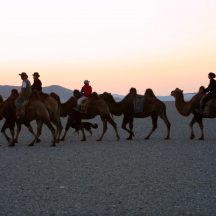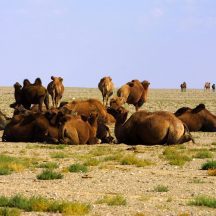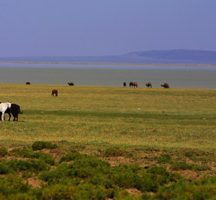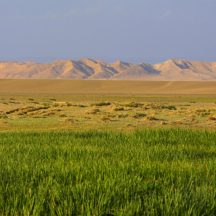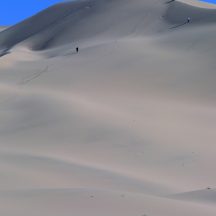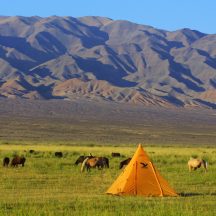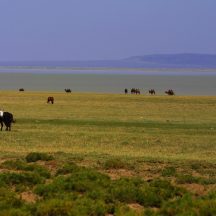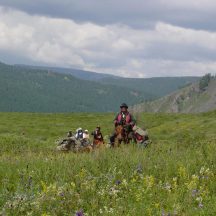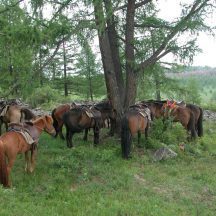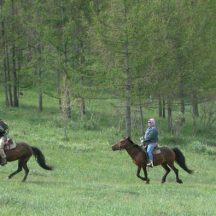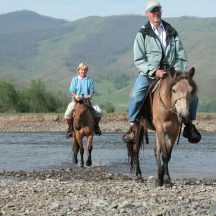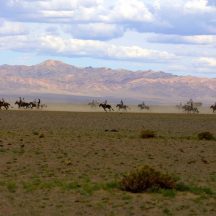Horseback Riding in Mongolia
Ask anyone who has spent much time in Mongolia, and they will confirm that seeing the country from the back of a horse is by far the best viewpoint, and in fact the only means of transportation that makes any sense at all. This is true in Mongolia as nowhere else on earth for three reasons. First, the roads are in such abominable condition, and the Russian-made vehicles so lacking in passenger comforts as to render sightseeing by car a trial of endurance rather than a convenience. Second, the landscape is ideally suited to travel by horseback.
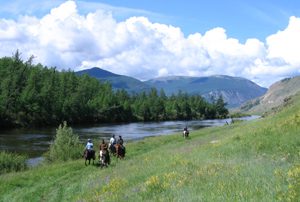
…no fences, no power lines, no paved roads, or cities to speak of…
The vast steppe, a grassland of breathtaking proportions with no fences, no power lines, no paved roads, or cities to speak of, stretches north to Russia and south to China, with nothing but mountains and rivers to sway one’s line of travel. When the steppe gives way to the mountains, even the jarring roads end and the only way to continue is on foot or horseback. Finally, the horse is an integral part of the Mongolian people and their culture. Riding is as elemental as breathing; it is inconceivable that life can exist without horses. Hence, riding becomes a perfect segue into what may otherwise be a completely strange and alien way of life.  The Mongolians, particularly in the countryside, are naturally warm, hospitable, and quick to laugh. They invite strangers into their gers, generously offer milk tea and cheese curds, answer and ask questions. Travelers arriving by horseback have the advantage of living within a framework familiar to both cultures, and conversation flows quicker and easier as a result. Mongolia is huge, and varied, and there were many places I was anxious to see. I decided on the Spirit of the Reindeer Herders, a trek into the roadless mountains of the north to see the nomadic Tsaatan people, then across the mountain passes to Lake Khovsgol which is reputed to be the most beautiful sight in Mongolia. And because that is a very atypical corner of the country, I added on another trek on the steppes south of Ulaanbaatar along the fringe of the Gobi where the scenery is classic grasslands dotted with white gers and herds of domestic horses, goats and sheep.
The Mongolians, particularly in the countryside, are naturally warm, hospitable, and quick to laugh. They invite strangers into their gers, generously offer milk tea and cheese curds, answer and ask questions. Travelers arriving by horseback have the advantage of living within a framework familiar to both cultures, and conversation flows quicker and easier as a result. Mongolia is huge, and varied, and there were many places I was anxious to see. I decided on the Spirit of the Reindeer Herders, a trek into the roadless mountains of the north to see the nomadic Tsaatan people, then across the mountain passes to Lake Khovsgol which is reputed to be the most beautiful sight in Mongolia. And because that is a very atypical corner of the country, I added on another trek on the steppes south of Ulaanbaatar along the fringe of the Gobi where the scenery is classic grasslands dotted with white gers and herds of domestic horses, goats and sheep. 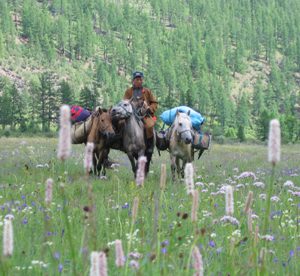

Dressed in their traditional dells with bright orange sashes, they were skilled horsemen, attentive guides, and cheerful traveling companions.
A factor that quickly became apparent, is how much a trip like this depends on a knowledgeable interpreter and a reliable, competent horse guide. In both cases, we had the best I can imagine finding. Aruna, our guide and interpreter, had an excellent — but charmingly imperfect –command of the English language. But perhaps more important, she had a human warmth and a genuine respect for us, the trek staff, and the people we encountered en route. The horsemen also were beyond reproach; competent with horses, saddles and packing what must have seemed to them like a ridiculous amount of gear. Dressed in their traditional dells with bright orange sashes, they were skilled horsemen, attentive guides, and cheerful traveling companions. They knew the country, knew the horses, and sang or whistled as we rode along. I would follow these handsome, hardworking men to the end of the earth – and some days it seemed we were nearly there. In addition, we had a superb cook who, with his younger sister to assist, turned out the most remarkable meals day after day. Mongolia is not renowned for its fine cuisine, but our cook had been professionally trained to cater for non-natives and his ability to provide delicious meals for the us (including a vegetarian), and for the Mongolian staff (who ate a completely different menu), all from equipment and supplies packed on the back of a horse, is nothing short of miraculous.
Not the least in the long list of remarkable creatures were the horses. Mongolian horses are short, not more than 14hh, with rather large, unrefined heads. They have not been sought for breeding, and through the centuries have remained pretty much undisturbed on the steppe, as the secret weapon of the Mongolians. These unassuming little horses are tough as wire, surefooted, have incredible stamina, amiable characters, and are superbly adapted to the harsh Mongolian winters. They may never see the inside of a fenced enclosure, and will spend their lives unshod. Mounted on these horses, Ghengis Khan and his army of skilled archers — the Golden Hordes — were able to conquer much of Asia and Eastern Europe, and establish the largest empire the world has ever seen.
One would think with such a noteworthy entourage we would have accomplished much more than mere sightseeing. But that in fact was our goal, and we did it very well, even considering the unprecedented rainfall. We rode north into mountains, following clear rivers through valleys flaunting the most stunning display of wildflowers I ever hope to see. Miles and miles of waving grass and flowers, with every turn in the trail and rise in elevation bringing a new combination of colors. Our campsites were pristine, and solitary, until at last we reached the Tsaatan (or Dukha) people and their herds of reindeer, where we spent a day observing this vanishing culture. We were very careful to follow the admonitions of our guide, who cautioned us against looking into the eyes of the Tsaatan men for fear of becoming enchanted and remaining forever in the tundra at the edge of Siberia.
We packed up, turned south and east, and rode toward Lake Khovsgol, a younger and smaller sister of Lake Baikal, and which the Mongolians affectionately refer to as “the ocean.” The rain continued, the rivers were higher than the horsemen had ever seen, and our predicted route changed twice. We spent an afternoon and evening with a family in their log cabin and ger, waiting for the head horseman to gather news about the condition of the river upstream. At the family’s invitation, we spent the night inside, warm and snug as the rain continued. We looped south for a different crossing further upstream.
Eventually the rain stopped, and we forded the Arsayn River with water up to our thighs and the horses bracing against the current. We crossed the sodden pass, careful to circle the ovoo (shrine at a pass or crossroads) three times and pray to the spirit of the mountain for safe passage. Lake Khovsgol is blue as a jewel, with impossibly clear water lapping the pebble shores for 136 kms from north to south. It is a heartstopping sight, and I cannot imagine a better way to see it than to ride down through larch and pine forests, catching brief glimpses of blue through the dark green trees.
Before going to Mongolia, I sensed it was not a destination suitable for everyone. That premonition was confirmed almost immediately upon landing in Ulaanbaatar, and continued to be reinforced for the 3 weeks I was there. One must keep in mind that Mongolia has only been open to western tourism since the Soviets withdrew in 1990. The hospitality industry, although growing quickly, is as yet a fledgling. Here’s the thing about Mongolia; you can spend your entire vacation listing the things that should be changed, or fixed, or improved. The roads, just for starters, the airplane schedules, the restaurant menus, the telephone system, the saddles. Your list will be long, almost endless, but in undertaking this task, you will have missed much of the country’s intrigue and unique character.
More than any place I’ve been before, Mongolia forces one to step back, relax, and wait patiently for the story to unfold. It will, as you watch and listen, though never quite in the way you expected.
Ellen Vanuga July 2006


